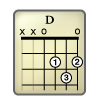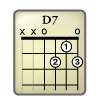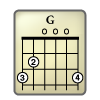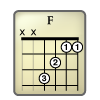This free guitar lesson teaches you how to play basic guitar chords that use open strings. These chords will help you learn countless songs across pop, rock, blues, country, and other music styles. Most content is taken from the curriculum found in eMedia Guitar Method, the award-winning interactive guitar lesson software that teaches you to play with songs and interactive music technology that can even listen to the notes you play.
Tips for Playing Basic Guitar Chords
- Make sure you know how to read guitar chord charts.
- Your hand should be in a C shape, perpendicular to the neck, with space between the curve of your hand and the neck. Your thumb should be opposite of your middle finger.
- Keep fingers arched and play with the tips of your fingers, to avoid accidentally muting other strings.
- Notes should be played slightly behind the fret, but not on the fret. This requires less pressure and creates better tone.
- Don’t push down on the strings with any more pressure than is needed to make the note(s) sound.
- Don’t be frustrated if chords don’t sound right at first. It takes time to learn how to play guitar chords.
- Chords can be strummed, or you can play the individual notes (called an arpeggio) to get a different sound.
How to Play Simple Guitar Chords
The chords below only require one finger to play. So if you are a totally new, beginning guitarist then you can start here and learn how to play easy chords on guitar before going on to learn the more difficult ones. They are the most basic guitar chords for beginners.
How to Play the Simple G Guitar Chord
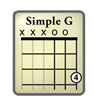 Strum Simple G by playing three strings with either pick, fingers or thumb while holding the indicated string down behind the 3rd fret with your pinky (see video). Don’t press down too hard.
Strum Simple G by playing three strings with either pick, fingers or thumb while holding the indicated string down behind the 3rd fret with your pinky (see video). Don’t press down too hard.
How to Play the Simple C and G7 Guitar Chords
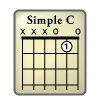
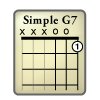 Strum the Simple C and G7 chords by playing three strings with either pick, fingers or thumb while holding the 1st finger as indicated in the chord charts. Be careful not to touch adjacent open strings with your left-hand finger.
Strum the Simple C and G7 chords by playing three strings with either pick, fingers or thumb while holding the 1st finger as indicated in the chord charts. Be careful not to touch adjacent open strings with your left-hand finger.
How to Play a Simple Bm Chord
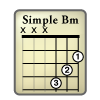 This Bm guitar chord is extremely simple to play.
This Bm guitar chord is extremely simple to play.
How to Play Open Guitar Chords
These are the common first position, open chord voicings found in many styles of music. Although these are relatively easy chords, they are found in many great guitar songs. Try to play these versions instead of the simple versions as soon as you can.
How to Play an E Chord
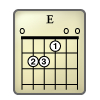
Open E is a very powerful sounding guitar chord, the root of the chord is E and can be heard in both the lowest and highest strings. In addition, all strings are being played. This is also a fairly easy chord to play on the guitar, as your fingers are close together and do not need to stretch too far. Remember to play each string at a time to be sure you are not accidentally muting a string.
How to Play an Em Chord
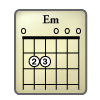 Em (E minor) is played the same way as E major, but you remove your first finger and let the open G string ring out. The Em is a very powerful sounding guitar chord due to all the open strings being used. Like all minor chords, it sounds a bit wistful and sad compared to a standard E chord.
Em (E minor) is played the same way as E major, but you remove your first finger and let the open G string ring out. The Em is a very powerful sounding guitar chord due to all the open strings being used. Like all minor chords, it sounds a bit wistful and sad compared to a standard E chord.
How to Play a C Chord
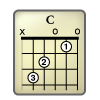 Here is the standard open C chord. Notice that by playing the extra lower strings that the chord sounds stronger and bolder than the simple version found earlier. This is because the C note (called the root of the chord) is being played on the lowest string.
Here is the standard open C chord. Notice that by playing the extra lower strings that the chord sounds stronger and bolder than the simple version found earlier. This is because the C note (called the root of the chord) is being played on the lowest string.
How to Play D and D7 Chords
Strum D by playing the four highest guitar strings. Some can remember the D chord easier by thinking of it as a triangle shape, with the D7 as an inverse of the triangle. Note that the video below also shows how to play the A7 chord.
How to Play a Dm Chord
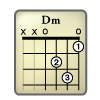 To play the Dm (D minor) chord, you use your first finger on the first fret of the first string, your third finger on the third fret of the B string, and your second finger on the second fret of the G string.
To play the Dm (D minor) chord, you use your first finger on the first fret of the first string, your third finger on the third fret of the B string, and your second finger on the second fret of the G string.
How to Play an A and A7 Chord
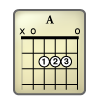
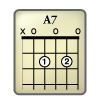 These chords use five strings, including the open A (which plays the root of the chord) and open E. Notice that you can play the A7 by simply lifting your second (2nd) finger.
These chords use five strings, including the open A (which plays the root of the chord) and open E. Notice that you can play the A7 by simply lifting your second (2nd) finger.
How to Play an Am Chord
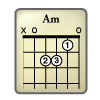 To play an Am (A minor) you basically take the E chord formation and move it over one string. Your first finger plays the first fret of the B string, the third finger plays the second fret on the G string, and your second finger is on the second fret of the D string.
To play an Am (A minor) you basically take the E chord formation and move it over one string. Your first finger plays the first fret of the B string, the third finger plays the second fret on the G string, and your second finger is on the second fret of the D string.
How to Play a G Chord
Learning how to play guitar chords will sometimes require some finger stretches. However, after you master the chords and are regularly playing the guitar, then the chords become second nature. To play open G, you must stretch your 3rd finger to play the G note (the root of the guitar chord) on the 3rd fret of your low E string.
How to Play an F Chord
The F chord has a reputation for being very difficult to play on the guitar. This is primarily because it requires using your first finger to hold down two adjacent strings (the E and B strings at the first fret). This is called a partial barre. With regular practice you will be able to play this chord. As with other chords, be sure to play all the individual notes one-at-a-time.
Learn New Guitar Chords and Techniques the Easy Way
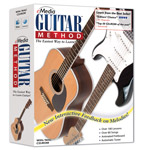 Now you can take the fast track to improving your guitar playing with eMedia Guitar Method, which includes over 180 easy-to-follow guitar lessons created by University of Colorado-Boulder’s Kevin Garry, Ph.D.. It features interactive technology that can listen to you play, let you slow-down and loop difficult parts and helps you learn over 70 easy guitar songs. Learn to play hits such as
Now you can take the fast track to improving your guitar playing with eMedia Guitar Method, which includes over 180 easy-to-follow guitar lessons created by University of Colorado-Boulder’s Kevin Garry, Ph.D.. It features interactive technology that can listen to you play, let you slow-down and loop difficult parts and helps you learn over 70 easy guitar songs. Learn to play hits such as Knockin’ on Heaven’s Door
and Rock’n Me
. eMedia Interactive Rock Guitar, which concentrates on rock guitar techniques, is also available if you’re a beginning rock guitarist. If you’re really serious about guitar, the eMedia Guitar Deluxe bundle contains both eMedia Guitar Method and eMedia Intermediate Guitar Method.
Use Those Basic Guitar Chords You Just Learned!
Now that you have learned how to play basic guitar chords, you can start using them in some songs or learn how to use them within the CAGED guitar system to make even more chords.
